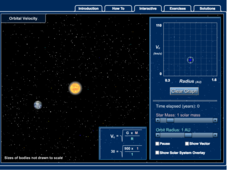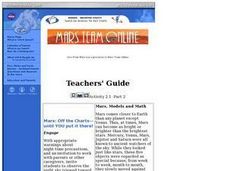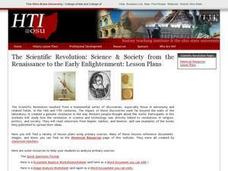Curated OER
Ellipses And Kepler's First Law
Students explain that planets actually orbit the center of gravity of the solar system, and that distant planets may be detected by motions of their central star around the centers of gravity of their planetary systems.
PBS
Data Plots of Exoplanet Orbital Properties
Scientists discovered the first exoplanet in 1995 and by early 2018, they confirmed the existence of more than 3,700—that's a lot of data! As part of the PBS 9-12 Space series, scholars interpret data about exoplanets. They compare...
CK-12 Foundation
Journey to Mars
Why are there launch windows when traveling to outer space? Scholars explore the trajectory of traveling from one planet to another. By adjusting the departure and destination planets, as well as the launch date, they observe the ideal...
Rice University
College Physics for AP® Courses
Take a look at an organized physics course. The 34-section electronic textbook covers material in AP® Physics 1 and 2. Teachers use the text to supplement lectures and have the class work through the labs. Each section contains multiple...
McGraw Hill
Extra Solar Planets Interactive
Studying what you can't see can be challenging. Discover how scientists use indirect measurements to prove the existence of planets and estimate their sizes. The introduction explains the symbiotic movement of planets and stars during an...
McGraw Hill
Orbital Velocity Interactive
Why does it take Pluto 90,000 days to orbit the sun, but it only takes Mercury 88 days? An interactive lesson helps pupils find a connection between the speed of orbit and distance a planet is from the sun. The simulation allows for...
CK-12 Foundation
Orbital Motion
Why do planets orbit the sun in ellipses when moons orbit their planet in circles? Pupils control the semi-major axis, eccentricity of the orbit, and position angle. The resulting orbital appears with the related force vectors as...
Curated OER
Meet the Neighbors: Planets Around Nearby Stars
Students explain why a transiting planet causes a periodic dimming in the light from its parent star. They determine the radius of a planet, and its orbital distance, by analyzing data and manipulating equations. Students compare the...
Curated OER
Mathematics at the Frontier of Astronomy
Students explore the different types of measurements used in astronomy. In this space science activity, students explain the relationship between planets' orbits and distance from the sun using Kepler's Laws. They discuss how math aides...
Curated OER
Mars: Off the Charts--Until You Put It There
Students explore the night sky and make illustrations which are shared in class the next day. Distinctions are made between the stars and the planets and views of the constellations for the season are made available. The work of early...
Curated OER
Orbital Motion
Students use a formula to measure the eccentricity of an ellipse, then state Kepler's Law of Elliptical Orbits. They predict the solar energy received at different positions in a planet's orbit.
Space Awareness
The Engine of Life
There is a specific zone, or distance from a star, that a planet must be in order to have water in a liquid form. The activity demonstrates how flux density depends on its distance from the source. A photovoltaic cell gets power to drive...
Curated OER
Space Exploration to Find Habitable Planets
Students explore space science by reviewing scientific vocabulary terms. In this planet identification lesson, students identify the nine planets in our solar system and discuss which ones could potentially harbor life at some point....
Curated OER
Quotes by Hobbes, Locke, Montesquieu, Rousseau, and Voltaire
In Enlightenment quotations study guide worksheet, students read quotations and identify the speakers as Hobbes, Locke, Montesquieu, Rousseau, Peter the Great, Copernicus, Louis XIV, Galileo, Harvey, Kepler , Frederick the Great, or...
Curated OER
Worksheet 19: Ship Positions
In this math worksheet, students read informational paragraphs and then answer 18 questions using data from their readings. Questions are about vectors, positions, distance and orbits.
Curated OER
Reading Comprehension 6
Set the timer for five minutes (or less), and distribute this resource to your class. There's a very short reading passage followed by a set of three questions. What a great tool in prepping your class for upcoming state testing.
Curated OER
The Scientific Revolution
Scientists participate in studying how new scientific advances have changed the world. They explain how astronomers have changed the way people view the universe, summarize the advances that were made in chemistry and medicine, and...
Laboratory for Atmospheric and Space Physics
Orbit Simulator
Researchers think they have evidence of a new planet deep in our solar system that is the size of Neptune and orbits the sun far beyond Pluto. The orbit simulator shows the orbits of our well-known planets, as well as Pluto and the comet...
Glynn County School System
Milky Way Galaxy
There is more about the Milky Way that scientists don't know than what they do know—that leaves a lot to discover! A thorough lesson presentation explores the components of the Milky Way Galaxy and their behaviors.
Curated OER
Orbital Bliss
Most young mathematicians are aware that the planets don’t orbit the sun in a circle but rather as an ellipse, but have never studied this interesting feature. This resource looks at the planetary orbits in more detail and helps learners...
Curated OER
Solving Math Problems In the Real World
Upper elementary and middles schoolers discuss and solve real world applications of math. They use formulas for volume and percents to answer real world questions. In the second part of the instructional activity, groups write and solve...
Curated OER
English Vocabulary Skills: AWL Sublist 9 - Exercise 2b
In this online interactive English vocabulary skills instructional activity, students answer 10 matching questions which require them to fill in the blanks in 10 sentences. Students may submit their answers to be scored.
Curated OER
On the Shoulders of Giants
Students select an astronomer or scientist from the past, research the role that they played in the development of the heliocentric revolution, and make presentations on their achievements.
Curated OER
Orbital Mechanics
Twelfth graders examine the misconceptions of Newton's laws of motion. In this motion and gravity activity students interpret data and see the effects of gravity.
Other popular searches
- Kepler's Laws
- Copernicus and Kepler
- Kepler's 3rd Law
- Kepler's Second Law
- Kepler Laws
- Kepler and Newton
- Johannes Kepler
- Keplers Laws
- Johann Kepler
- Kepler Copernicus Brahe
- Who Is Johannes Kepler
- Astronomy Kepler

























